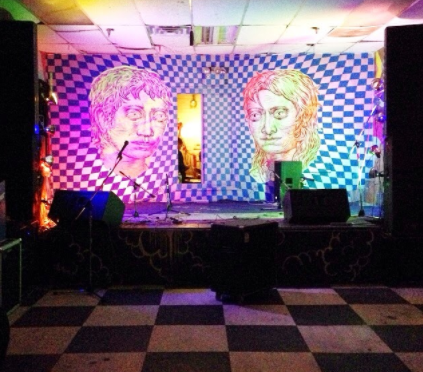When I first moved to New York in June of 2010, I quickly became acquainted with the venue in a roundabout way thanks to a certain unnamed friend’s romantic dalliance with a member of Turbo Fruits. It was suggested I stop in. The date was October 16th when they blew through town and played with Pujol (a band that would also turn my body into a sweating mess later on in the dead of winter at 285 Kent), along with Liquor Store and Dream Diary. I was at the point in my NYC existence where everything was new and exciting, so I admit my coherence that night can be summed up by the photo featured below.

Nonetheless, it didn’t mean my inebriated self couldn’t pick up on a certain vibe. The close-knitness of the crowd, moving to and absorbing the band onstage like a singular organism. When I awoke to the feel of some beer cans on top of my head, I knew I needed to come back. I was still under twenty-five then, mind you, and this was just the sort of “scene” my youthful persona craved at that time–the thing that would bind me to Brooklyn in a way I had only thought possible in movies about New York.
The loving and affectionate director of the documentary, co-founder Matthew Conboy, describes unearthing the warehouse space back in 2005 (the last time Williamsburg was its true self as a result of a now notorious re-zoning law), when the only rule the landlord had was essentially “don’t complain about anything repairwise and you can make as much fucking noise as you want.” And make noise Death by Audio did. Originally named for the effect pedal company that Oliver Ackermann, frontman for one of the venue’s most famed bands, A Place to Bury Strangers, helped to create, the work/live space quickly evolved into the hub of thriving new band energy. As noted in the documentary, the venue was already featured in publications like Time Out New York within months of opening. At the time, Conboy had just graduated from college with a degree focused on fiction and playwriting, and, as he freely admitted, wandered New York wondering what the fuck he was going to do with his life (something I still do, to be honest). When he linked up with Ackermann and asked to learn what he knew about pedal design, Ackermann was more than happy to serve as mentor.
The other components in the formula, Jason Amos–”the owner guy”–and Edan Wilber–”the aesthetic/sound perfectionist guy”–combined to put their unique stamp on the venue. And it seemed like there was no turning back once the well-oiled machine began, with construction on the warehouse paying for itself in ticket sales. The state of constant building at Death by Audio never seemed to stop throughout its existence, even when it was technically crumbling–mostly at the hands of the construction crew overhead. And, like most great films, Goodnight Brooklyn has an unstoppable villain–which is, of course, VICE–the being that implemented said construction crew while waiting eagerly to overtake the space. The former champion of independent music culture and trends was once a small-scale operation based out of Montreal, and founded by Shane Smith (wait for the “Fuck You Shane” graffiti moment in the movie), Suroosh Alvi and Gavin McInnes. Around the time it started getting major investments from Rupert Murdoch, it became the very thing it used to stand against, and, suddenly, destroying the music venues it once championed became a no-brainer for financial reasons (Glasslands and 285 Kent would also fall prey to the Williamsburg pillaging of VICE).

Roaming the streets near South 2nd and Kent in a sublime alcohol-induced stupor was made all the more beautiful by being able to stumble in to Death by Audio any given night and find something magical happening onstage. For it to be taken away by, of all entities, VICE is almost too rife with irony and cruelty. Yet, if it hadn’t been VICE, it surely would have been some other corporation equally as tied to selling Brooklyn back to itself. As Conboy admits, “We’re part of what made this neighborhood attractive,” and once it became so, there was no stopping the gentrification juggernaut that artists are both responsible for and suffer from when the richies catch wind.
Nonetheless, Goodnight Brooklyn is the documented history Death by Audio deserves–showcasing performances from Dan Deacon, Grooms, Future Islands, A Place To Bury Strangers and JEFF the Brotherhood, among others. No one wanted to see it go, because everyone knew what it represented and what its demise was signaling.
There is an honesty and a purity to what comes out of a DIY space–because the thought of profit is not involved. And even though the aura that emanated out of Death by Audio might never be re-created again, this documentary is, if nothing else, a call to arms for musicians everywhere to keep the DIY concept alive.
P.S. VICE is the embodiment of the corporation that will sell a noose to hang itself if it means making money. And their insistence, “Brooklyn is our home and we’re already hard at work developing a freaky, space-age utopia that will give today’s creative visionaries a place to produce astonishing stories and leave their indelible thumbprint on the annals of history,” could not be further from the truth, nor can it ever compensate for the soulless music scene they’ve set in motion.






















